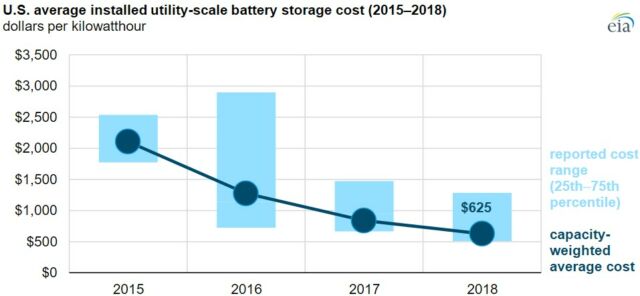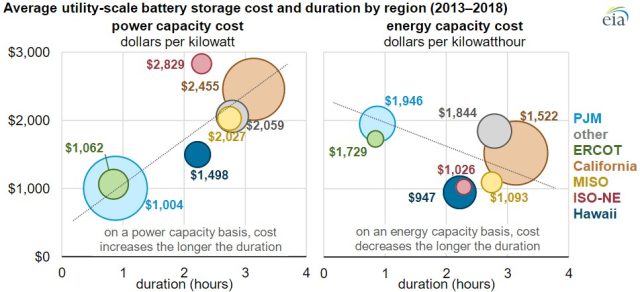US grid-battery costs dropped 70% over 3 years

In recent years, the cost of solar and wind energy has declined precipitously, which has accelerated the growth of these renewable energy technologies. Increasingly, utilities are now planning for a future grid dominated by solar and wind. That will require changes in grid management and transmission upgrades as well as the addition of storage to smooth out the supply from variable generators.
Grid storage is still pretty early days, but we’re already seeing huge cost reductions as the industry matures. The US Energy Information Administration (EIA) highlighted this recently, showing that grid-scale battery-project costs in the United States dropped 70 percent in just a few years.
Between 2015 and 2018, average project costs decreased from $2,152 per kilowatt-hour of storage to $625. Costs will need to drop much more for grid batteries to scale, but that’s a huge improvement in a short period of time.

By the end of 2018, the US had 869 megawatts of battery power capacity and 1,236 megawatt-hours of energy capacity. (Power is the rate at which the batteries can supply electricity, while energy is the total amount it can supply when going from full charge to empty.) EIA also has installation data for 2019, which saw the addition of another 150 megawatts/450 megawatt-hours. And in just the first seven months of 2020, yet another 300 megawatts of power capacity were installed.
EIA doesn’t see this slowing down. It expects installed battery storage to increase by 6,900 megawatts “in the next few years”—a figure ambiguous enough to allow for a rapid spike in planned projects.
While you might think that one battery is more or less the same as another, there are regional differences hidden within the average costs of recent projects. In in the Midwest-to-mid-Atlantic region of the grid managed by PJM, for example, the average cost between 2013 and 2018 was $1,946 per kilowatt-hour. Projects in Hawaii averaged just $947 per kilowatt-hour.

Much of this difference can be explained by the fact that batteries are serving many different purposes. In the PJM region, for example, that cost drops to $1,004 if you calculate it per kilowatt rather than per kilowatt-hour. And by that metric, Hawaii’s average cost goes up to $1,498.

